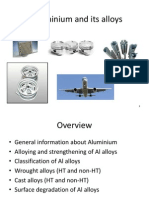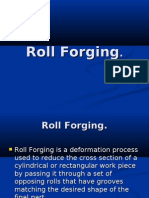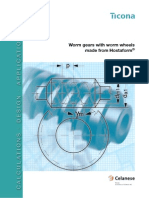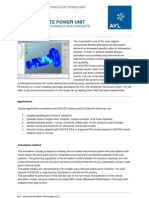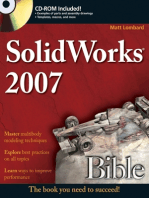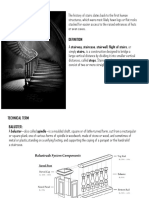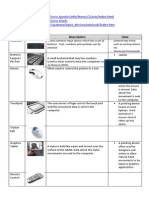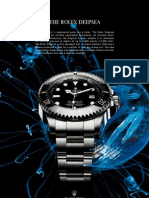Aluminum Sheet Forming For Automotive Applications,: Material Properties and Design Guidelines
Aluminum Sheet Forming For Automotive Applications,: Material Properties and Design Guidelines
Uploaded by
ShreeJayadurgaaCopyright:
Available Formats
Aluminum Sheet Forming For Automotive Applications,: Material Properties and Design Guidelines
Aluminum Sheet Forming For Automotive Applications,: Material Properties and Design Guidelines
Uploaded by
ShreeJayadurgaaOriginal Title
Copyright
Available Formats
Share this document
Did you find this document useful?
Is this content inappropriate?
Copyright:
Available Formats
Aluminum Sheet Forming For Automotive Applications,: Material Properties and Design Guidelines
Aluminum Sheet Forming For Automotive Applications,: Material Properties and Design Guidelines
Uploaded by
ShreeJayadurgaaCopyright:
Available Formats
12
JANUARY/FEBRUARY 2013 WWW.STAMPINGJOURNAL.COM STAMPING JOURNAL an fma publication
R&D UPDATE
Editors Note: This is Part I of a two-part series that
discusses the forming of aluminum sheet for auto-
motive products. Part II, to appear in the March/
April 2013 issue of STAMPING Journal
, will
discuss the lubricants used in aluminum forming.
A
luminum is used extensively
for such automotive parts as
hoods, trunk lids, and doors
because of its light weight, workabil-
ity, and recyclability. and its market
share continues to increase.
Commonly Used Alloys
The 5xxx and 6xxx aluminum alloys
are used most commonly for auto-
motive applications. Their mechani-
cal properties for automotive body
sheets are listed in Figure 1, and
their specic properties and main dif-
ferences are shown in Figure 2.
The 5xxx alloys have ultimate ten-
sile strength of 125 to 350 MPa and
cannot be heat-treated. They have
relatively good formability and are
highly resistant to corrosion. How-
ever, 5xxx alloys are prone to the
formation of Lders bands during
forming, so they are used mostly for
inner-panel applications. 5182 and
5754 are the principal 5xxx series
alloys used in autobody panels. 5754
also is recommended for elevated-
temperature applications.
The 6xxx series alloys are heat-
treatable to reach ultimate tensile
strength of 125 to 400 MPa. The
alloys, especially 6022 and 6111,
often are used for outer panels since
they are precipitation-hardened and
free of Lders bands.
Design Guidelines and
Requirements
The key requirements for automotive
closures are panel bending stiffness
and dent resistance. The elastic mod-
ulus of aluminum (70 GPa) is about
one-third that of steel (210 GPa). As
a result, parts previously designed for
steel need to be redesigned to achieve
the same stiffness.
One way to improve stiffness in
aluminum is to increase the ribbing
used in the product or increase the
part thickness. For closures and
body-structure sheets, the thickness
should be increased by a factor of
about 1.45:
1
where: t = thickness
E = Youngs modulus
The resulting weight saving is
about 50%:
Another important design criterion
for aluminum alloys is dent resistance
for static and dynamic conditions. To
reach a static dent resistance com-
parable to steels, aluminum sheet
should meet the following thickness
requirement:
Where: t = thickness
YS = yield strength
Figure 3 shows the aluminum
sheet properties compared to those
of steel, based on dynamic dent resis-
tance studies.
Figure 4 shows the weights
of three different hoods made of
mild steel, high-strength steel, and
Al6016, respectively. For mild steel,
the reduction in weight is limited by
the dent resistance; for high-strength
steel, it is limited by local stiffness.
When the hood is made of Al6016,
its weight can be reduced by 50 per-
cent.
Critical Material
Parameters
Some critical parameters are different
for aluminum than steel, and they
affect formability:
Aluminum sheet forming
for automotive applications,
Part I
Material properties and design guidelines
BY TINGTING MAO AND TAYLAN ALTAN
Alloy
Mechanical Properties
Ultimate Tensile
Strength (MPa)
Yield Strength
(MPa)
Elongation
(%) n-value r-value
5000
Series
AA5022 275 135 30 0.3 0.67
AA5023 285 135 33 - -
AA5182 265 125 28 0.33 0.8
AA5052 190 90 26 0.26 0.66
AA5754 212 90 22 0.34 -
6000
Series
AA6022 275 155 31 0.25 0.6
AA6016 235 130 28 0.23 0.7
AA6111 290 160 28 0.26 0.6
Figure 1
The mechanical properties of several aluminum sheet alloys for automotive applica-
tions are shown here. Source: T. Sakurai, The latest trends in aluminum alloy sheets
for automotive body panels, Kobelco Technology Review, No. 28 (Oct. 2008).
t
aluminum
t
steel
= =
E
steel
E
aluminum
3
1.44
mass
aluminum
mass
steel
density
alu
density
steel
=
1.44
=
1.44
=
0.5
2.7
7.8
t
aluminum
t
steel
YS
steel
YS
aluminum
13 an fma publication STAMPING JOURNAL WWW.STAMPINGJOURNAL.COM JANUARY/FEBRUARY 2013
R&D UPDATE
Elastic ModulusWith an elas-
tic modulus one-third that of steel,
aluminum parts experience more
springback. This can be reduced by
increasing the blank holder force,
the amount of stretching, and sheet
thickness. The forming operation
must be optimized to ensure at least
2 percent stretch throughout the part
(see Figure 5).
FrictionFriction between the
tool and the aluminum sheet is
expected to be higher compared to
steel sheet because aluminum has a
surface roughness (Ra) from 0.25 to
0.38 micron. In comparison, the Ra
of steel sheet is about 0.63 to 0.88
micron. The smoother texture of alu-
minum requires dry, waxlike lubri-
cants.
FormabilityFor the stamping
of autobody parts, the lower form-
ability of aluminum compared to steel
can be offset to some extent by using
technology such as advanced adden-
dum design, local blank holder force
control with multiple-point hydrau-
lic cushions, or warm forming. Warm
forming using heated dies and heated
blanks has been investigated exten-
sively, and recent studies have shown
that the use of heated dies compli-
cates the process and increases costs.
Present R&D efforts are focused on
heating the sheet to warm forming
temperature while keeping the dies
at room temperature.
Researchers hope to establish a
practical and robust process that
increases the formability of alumi-
num sheet for forming more complex
parts with difcult geometries.S
Tingting Mao is a graduate research associate and
Taylan Altan is professor and director of the Cen-
ter for Precision Forming (CPF) at The Ohio State
University, 339 Baker Systems, 1971 Neil Ave.,
Columbus, OH 43210, 614-292-5063, www.
cpforming.org and www.ercnsm.org.
Notes:
1. The Aluminum Automotive Manual, version
2011, European Aluminum Association.
Figure 2
Properties and forming characteristics vary among the 5xxx and 6xxx alloys used for
manufacturing car body components. Source: I.J. Hirsch, Automotive trends in alu-
minum The European Perspective, Aluminum Alloys: Their Physical and Mechani-
cal Properties: proceedings of the 9th International Conference on Aluminum Alloys
(ICAA9), eds. B. Muddle, A. Morton, and J. Nie (Institute of Materials Engineering
Australasia, 2004).
Figure 5
Strains of at least 2 percent are neces-
sary when stamping aluminum to
reduce springback. Source: W. Thomas
and T. Altan, Saving weight with alumi-
num stampings Part II, STAMPING
Journal, July/August 1999, p. 84.
Figure 4
Automobile hood weight decreases substantially when Al6010 is used rather than
steel. Source: Design with Aluminum (European Aluminum Association, 2011).
Figure 3
This graph compares yield strength of
aluminum and steel based on dynamic
dent resistance studies. Source: Design
with Aluminum (European Aluminum
Association, 2011).
L
i
f
e
C
y
c
l
e
F
o
r
m
in
g
J
o
i
n
i
n
g
Surface Appearance
D
e
n
t
R
e
s
i
s
t
a
n
c
e
Stretchability
C
o
r
r
o
s
i
o
n
R
e
s
i
s
t
a
n
c
e
D
e
e
p
D
r
a
w
a
b
i
l
i
t
y
Quality
W
e
l
d
a
b
i
l
i
t
y
Properties
Process Chain
AA6016
AA6111
AA5182
AA5754
Reference Steel Panel YS (MPa)
200 250 300 350 400
260
220
180
140
100 A
l
u
m
i
n
u
m
P
a
n
e
l
Y
S
f
o
r
5
0
%
W
e
i
g
h
t
S
a
v
i
n
g
(
M
P
a
)
A
u
t
o
m
o
b
i
l
e
H
o
o
d
t
Design Criteria Specication
Mild Steel
(YS = 200 MPa)
High-strength Steel
(YS = 300 MPa)
AI 6016
(YS = 150 MPa)*
Dent Resistance YS t
2
Cte t 0.8 t 0.65 t 0.92
Local Stiffness E t
2
Cte t 0.7 t 0.7 t 1
Weight (kg) 14 12.4 6.1
* After Deformation and Paint Baking
You might also like
- STJLR.01.5161 Requirements For Measurement Data Submissions (PIR) Ver. 3Document33 pagesSTJLR.01.5161 Requirements For Measurement Data Submissions (PIR) Ver. 3dhuntNo ratings yet
- OPERATING MANUAL Biomass BoilerDocument23 pagesOPERATING MANUAL Biomass BoilerCORPORACION VENMATCO100% (1)
- Small Commercial Vehicles India 2022Document26 pagesSmall Commercial Vehicles India 2022tussi_91100% (1)
- 008 Selection of Alternative Material For Car Roof PanelDocument10 pages008 Selection of Alternative Material For Car Roof PanelyasinNo ratings yet
- Ticona Molded Plastic Gear Design PDFDocument6 pagesTicona Molded Plastic Gear Design PDFMonica BoccaNo ratings yet
- Deep Beam Design Based On ACI 318-14: Input DataDocument3 pagesDeep Beam Design Based On ACI 318-14: Input DataahmedhusseinkamelNo ratings yet
- 2 Mark Questions With AnswersDocument3 pages2 Mark Questions With AnswersMonica Purushothaman50% (2)
- Cost Reduction and Light Weighting (BIW)Document25 pagesCost Reduction and Light Weighting (BIW)tran hungNo ratings yet
- Spot WeldingDocument34 pagesSpot WeldingLucas CavalcantiNo ratings yet
- Tailor Welded BlanksDocument52 pagesTailor Welded BlanksYuvaraj YuvarajNo ratings yet
- Tolerance Band PDFDocument3 pagesTolerance Band PDFSuresh DatalNo ratings yet
- JLR-STN-56258 - Problem Solving Standard 3.2Document25 pagesJLR-STN-56258 - Problem Solving Standard 3.2dhuntNo ratings yet
- Stack Up AnalysisDocument6 pagesStack Up AnalysisKarthikeyan PandiarasuNo ratings yet
- Study and Analysis of Automotive Seating System Riser Design & Development For M1 Category VehicleDocument8 pagesStudy and Analysis of Automotive Seating System Riser Design & Development For M1 Category VehicleFabian BessonNo ratings yet
- Csstings or ForgingsDocument10 pagesCsstings or ForgingsRajaSekarsajjaNo ratings yet
- High Ductility Aluminum Alloy Made From Powder by Friction ExtrusionDocument6 pagesHigh Ductility Aluminum Alloy Made From Powder by Friction ExtrusionRaistlin1No ratings yet
- Validation of Salt Spray Corrosion TestDocument7 pagesValidation of Salt Spray Corrosion TestMateiNo ratings yet
- Crashworthiness Aspects of Electric Vehicle DesignDocument21 pagesCrashworthiness Aspects of Electric Vehicle DesigngfdczxNo ratings yet
- Gears HoningDocument7 pagesGears Honingsav33No ratings yet
- Gregory A. Fett - Importance of Induction Hardened Case Depth in Torsional ApplicationsDocument5 pagesGregory A. Fett - Importance of Induction Hardened Case Depth in Torsional ApplicationsFelipe NovaisNo ratings yet
- Final Report Me513Document32 pagesFinal Report Me513Ahmad Humaizi AzharNo ratings yet
- AHSS Guidelines V5.0 20140514Document276 pagesAHSS Guidelines V5.0 20140514medane_saad6707No ratings yet
- IFI 100 Prevailing Torque LocknutsDocument7 pagesIFI 100 Prevailing Torque LocknutsMarceloGonçalvesNo ratings yet
- 5 - Aluminium Alloys 2010-2011Document52 pages5 - Aluminium Alloys 2010-2011Busta137No ratings yet
- Roll Forging.Document36 pagesRoll Forging.jaydee420No ratings yet
- A Kinematic Analysis of Meshing Polymer Gear TeethDocument16 pagesA Kinematic Analysis of Meshing Polymer Gear TeethsandeepNo ratings yet
- Outokumpu Forta Range Stainless Steel DatasheetDocument16 pagesOutokumpu Forta Range Stainless Steel DatasheetNicola D'ettoleNo ratings yet
- Dts Presentation (Sliding Bearing Materials)Document11 pagesDts Presentation (Sliding Bearing Materials)Vaibhav KirtiwarNo ratings yet
- Design and Analysis of Progressive Tool in Sheet Metal ManufacturingDocument5 pagesDesign and Analysis of Progressive Tool in Sheet Metal ManufacturingVIVA-TECH IJRI0% (1)
- SKF Filament Wound BushingsDocument8 pagesSKF Filament Wound BushingsWes VendrigNo ratings yet
- Forming Curve SignificanceDocument14 pagesForming Curve SignificanceNishant PatilNo ratings yet
- Dayton Rogers Design Handbook E-EditionDocument42 pagesDayton Rogers Design Handbook E-EditionÉmilie RiverinNo ratings yet
- Altair's Student Guides - Instructor's Manual - CAE For Simulation of Sheet Metal FormingDocument26 pagesAltair's Student Guides - Instructor's Manual - CAE For Simulation of Sheet Metal FormingKFourMetrics100% (13)
- Determination of Forming Limit Curves On ARGOMDocument58 pagesDetermination of Forming Limit Curves On ARGOMEduardo Felippe de SouzaNo ratings yet
- Lasco MartelosDocument22 pagesLasco MartelosMu'minNo ratings yet
- Further Understanding of Rolling Contact Fatigue in Rolling Element Bearings - A ReviewDocument23 pagesFurther Understanding of Rolling Contact Fatigue in Rolling Element Bearings - A ReviewTomas MouryNo ratings yet
- Dimensioning Practice: Threaded FastenersDocument27 pagesDimensioning Practice: Threaded FastenersAfaq AslamNo ratings yet
- Silent BlockDocument21 pagesSilent BlockVijayGowthamanNo ratings yet
- A Review On Modeling and Analysis of Car Wheel Rim Using CATIA & ANSYS PDFDocument5 pagesA Review On Modeling and Analysis of Car Wheel Rim Using CATIA & ANSYS PDFHafiz M TahirNo ratings yet
- Selection of Joining Methods in Mechanical DesignDocument12 pagesSelection of Joining Methods in Mechanical Designac.diogo487No ratings yet
- Vibration Analysis of Metal - Polymer Sandwich StruDocument26 pagesVibration Analysis of Metal - Polymer Sandwich StruSURESH KUMAR APNo ratings yet
- Fatigue and Static Structural Analysis of Car Wheel Using Finite Element Method - A Review-34038Document6 pagesFatigue and Static Structural Analysis of Car Wheel Using Finite Element Method - A Review-34038kiran_sridharaNo ratings yet
- Sheet Metal FastenersDocument15 pagesSheet Metal FastenersSudath KularathnaNo ratings yet
- Calculation of Retaining RingsDocument7 pagesCalculation of Retaining RingsDobrica PetrovicNo ratings yet
- Engineering & Design Handbook EditedDocument140 pagesEngineering & Design Handbook EditedHermanNo ratings yet
- Minimum Required InterferenceDocument4 pagesMinimum Required InterferenceParag NaikNo ratings yet
- Report Final - Upsetting of Engine Valves and Parametric Study On Engine ValvesDocument44 pagesReport Final - Upsetting of Engine Valves and Parametric Study On Engine ValvesAravind Srinivasan100% (1)
- CB Mark White Aluminium PresentationDocument17 pagesCB Mark White Aluminium PresentationSai KrishnaNo ratings yet
- Diseños de EngranajesDocument26 pagesDiseños de EngranajesTarja Turunen MexicoNo ratings yet
- Tooth Root Bending ISO6336 Poland PaperDocument14 pagesTooth Root Bending ISO6336 Poland PaperJuanNo ratings yet
- Design Calculation HandlingDocument51 pagesDesign Calculation HandlingArshad KhanNo ratings yet
- Comparison of Anti-Loosening Characteristics of Various M14 Threaded FastenersDocument8 pagesComparison of Anti-Loosening Characteristics of Various M14 Threaded Fastenerssoumyajit dasNo ratings yet
- Excite CrankshaftdynamicsDocument4 pagesExcite CrankshaftdynamicssarditomoNo ratings yet
- Cooling Thesis PDFDocument60 pagesCooling Thesis PDFAudel Albarrán CNo ratings yet
- TribologyDocument19 pagesTribologyMtech Design [Golden Batch]No ratings yet
- Automotive Chassis DesignDocument4 pagesAutomotive Chassis DesigndressfeetNo ratings yet
- Asymmetric Cylindrical GearsDocument6 pagesAsymmetric Cylindrical Gearsकृष्णकुमार दत्तात्रेय जोशीNo ratings yet
- Project Report: Metal FormingDocument14 pagesProject Report: Metal FormingohcomeonNo ratings yet
- Design for additive manufacturing A Clear and Concise ReferenceFrom EverandDesign for additive manufacturing A Clear and Concise ReferenceNo ratings yet
- Filter pc200Document2 pagesFilter pc200Importaciones e Inversiones CYHNo ratings yet
- Planning Grid Leaving Cert Construction StudiesDocument4 pagesPlanning Grid Leaving Cert Construction Studiesapi-544280724No ratings yet
- Pipe Schedules PDFDocument2 pagesPipe Schedules PDFpongpitsanu k.No ratings yet
- WorkBench Software Manual Version 2.4.1 PDFDocument504 pagesWorkBench Software Manual Version 2.4.1 PDFGilmar Peterle PaganiniNo ratings yet
- Burj Dubai - The Residences Emaar PropertiesDocument4 pagesBurj Dubai - The Residences Emaar PropertiesAhmedNo ratings yet
- TB 03 Calculations Normalisations ConversionsDocument17 pagesTB 03 Calculations Normalisations ConversionsRaul BxinNo ratings yet
- BENNI Catalog PDFDocument8 pagesBENNI Catalog PDFMoi Ky VillaNo ratings yet
- Design Project1Document19 pagesDesign Project1Syed Munawar Ali100% (1)
- Pokémon Clover Main Doc (New Edition) (Recovered)Document367 pagesPokémon Clover Main Doc (New Edition) (Recovered)maverickbastardNo ratings yet
- Automobile IndustryDocument30 pagesAutomobile IndustrychakshuNo ratings yet
- Resume RF Engineer LTE 4g Jobs LTE India South Central Asia PDFDocument3 pagesResume RF Engineer LTE 4g Jobs LTE India South Central Asia PDFsebaNo ratings yet
- Nexus Project Solutions Private Limited Daily Progress ReportDocument1 pageNexus Project Solutions Private Limited Daily Progress ReportschaktenNo ratings yet
- StaircaseDocument28 pagesStaircasepemo ezungNo ratings yet
- LC72130Document23 pagesLC72130Christian SegoviaNo ratings yet
- Basic Input Devices TableDocument4 pagesBasic Input Devices Tableapi-267050715No ratings yet
- Deep SeaDocument8 pagesDeep Seameor3705No ratings yet
- Qareport Flyer UsDocument2 pagesQareport Flyer UsArjunNo ratings yet
- Lecture 3 (Psychometric Chart) - Psychometric ChartDocument7 pagesLecture 3 (Psychometric Chart) - Psychometric ChartbalsamNo ratings yet
- Vector Webinar AUTOSAR Testing 20111115 enDocument32 pagesVector Webinar AUTOSAR Testing 20111115 enHai Le100% (1)
- Cables - Guide For Non-Destructive Diagnosis of Distribution Cable SystemsDocument72 pagesCables - Guide For Non-Destructive Diagnosis of Distribution Cable SystemscadtilNo ratings yet
- Recommendation LetterDocument2 pagesRecommendation Letterirshad hussain100% (1)
- 8-Bit Single-Chip Microcomputer With Ad Converter D78c10agq Nec Datasheet PDFDocument66 pages8-Bit Single-Chip Microcomputer With Ad Converter D78c10agq Nec Datasheet PDFAnonymous qWeFIfN90No ratings yet
- Proper Maintenance of InstrumentsDocument92 pagesProper Maintenance of InstrumentsDimi DimoNo ratings yet
- Ut 351 PDFDocument94 pagesUt 351 PDFLuis Alberto Parco AtanacioNo ratings yet
- 5Th Floor Plan 6Th Floor Plan: Part of KitchenDocument1 page5Th Floor Plan 6Th Floor Plan: Part of KitchenD.A.D.ANo ratings yet
- Pickhammers: IR2 - IR12Document4 pagesPickhammers: IR2 - IR12Jamal HabbasNo ratings yet
- Understanding DecimalsDocument71 pagesUnderstanding DecimalsROMNICK DIANZONNo ratings yet























